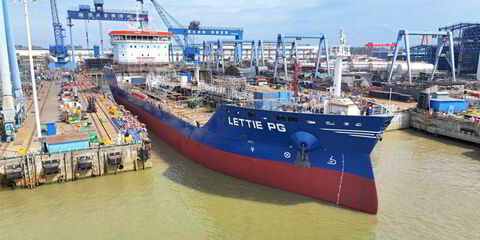This year looks set to be a record-breaking year on the container ship newbuilding front as orders have jumped by about 52% since January, according to figures from Veson Nautical.
The maritime data and freight management solutions provider said that 254 container ship newbuilding contracts been placed so far the year, compared with 167 in the same period last year.
Ordering has been fuelled by high charter rates and the post-Covid container boom, Veson noted in a reported published on Friday entitled Golden age: Container shipping’s post-Covid boom continues.
Neo-panamaxes accounted for about 41% of the current order tally for this year, followed by post-panamaxes at about 27% and ultra-large container ships at about 22%.
Such a high level of ordering has sent container ship newbuilding values soaring, according to the report’s author, Rebecca Galanopoulos, who is the senior content analyst at VesselsValue, Veson’s data intelligence arm.
Galanopoulos described values for container ship newbuildings as being at an all-time high.
“Newbuilding costs in this sector have risen due to increased demand, limited yard availability, climbing material costs and competition from other ship types occupying available spaces,” she said.
The value of a newbuilding type as cited in Galanopoulos’ report represents VesselsValue’s estimated market value for the type, not the exact price that shipowners may have contracted their ships for.
AP Moller-Maersk’s October order for up to 10 LNG dual-fuelled 16,000-teu boxships at Hanwha Ocean was priced at $209.6m per ship although VesselsValue estimates their current market value to be $225m each.
Ultra-large container ship newbuilding values are currently pegged by VesselsValue at $281m as compared to $213.2m a year ago, a one-year change of 32%.
Neo-panamax newbuilding values are at $210.50m as compared to $158.5m this time last year, an increase of about 33% year on year.
In the post-panamax sector, values have reached $114.7m, a 32% year-on-year increase from $87m.
Record deliveries but low recycling

Galanopoulos also described 2024 as a record year for container ship deliveries, but also the lowest in terms of recycling.
“There have been a considerable amount of newly delivered container vessels entering the fleet over the past few years, thanks to the post-Covid container boom.
“2024, represents a record year for new container vessels entering the market, so far this year there have been 362 vessels delivered, with a further 169 set to be delivered in the last few months of the year.
“At the same time, due to the firm earnings this year, removals remain low with just 48 Container ships sent for demolition, a fall of circa 45% year-on-year,” Galanopoulos said.
Last year saw container earnings dip from the highs of the pandemic years, as the market returned to normal following the boom period of the covid lockdowns.
Galanopoulos noted that since the beginning of 2024, container earnings have firmed once again and are currently up year on year across all sectors.
“This is due to the additional tonne-mile demand, which has arisen as a result of the hostilities in the Red Sea that have forced vessels to travel longer distances around the Cape of Good Hope.
“There are also several other factors contributing to the elevated TC rates at the moment such as a general rate increases set to go live from the middle of November, along with a strike in Canada and strong volumes traded. In the post-panamax sector, earnings are currently double the figure seen this time last year,” she said.
While the factors cited by Galanopoulos look set to continue for the foreseeable future, as TradeWinds reported on Thursday, the election of Donald Trump as the next US president could throw up major disruptions for the liner sector.
The liner sector is most vulnerable to Trump’s threats to implement tariffs of up to 20% on all imports into the US and additional tariffs of 60% to 100% on goods from China, which could lead to a retaliatory trade war.
This, according to liner analytics platform Xeneta, will force liner companies to adapt to more sustainable routes and trade patterns as businesses source from alternative markets to reduce the effects of US tariffs.
Ocean Network Express chief executive Jeremy Nixon stressed the need to adjust operations to align with tariff-induced trade pattern changes and near-shoring trends.
Other analysts predicted that Trump’s tariffs would also tank the US economy, which in turn have a negative effect on the global economy as a whole, leading to reduced consumer spending, one of the backbones of the liner sector.
However, Galanopoulos noted that while the average age of the total container fleet is 12 years, older vessels are still in abundant supply so there is some potential to scrap should operators need to trim their fleets if earnings fall.






